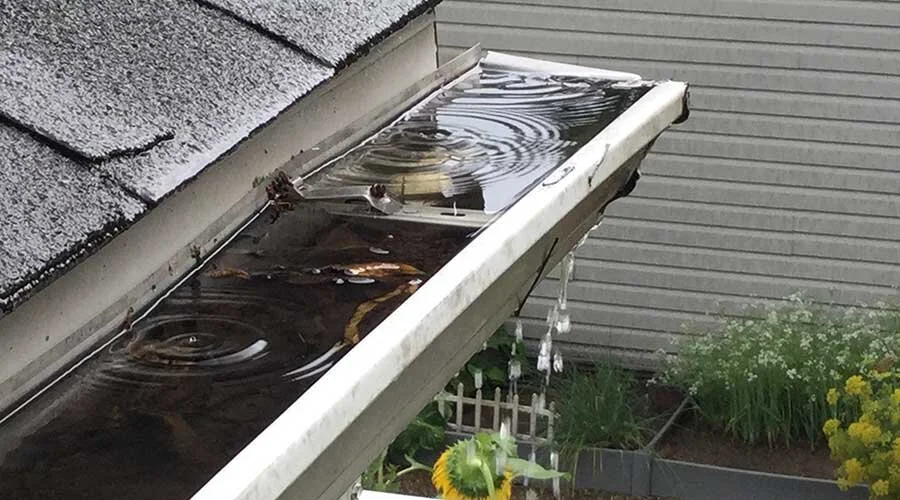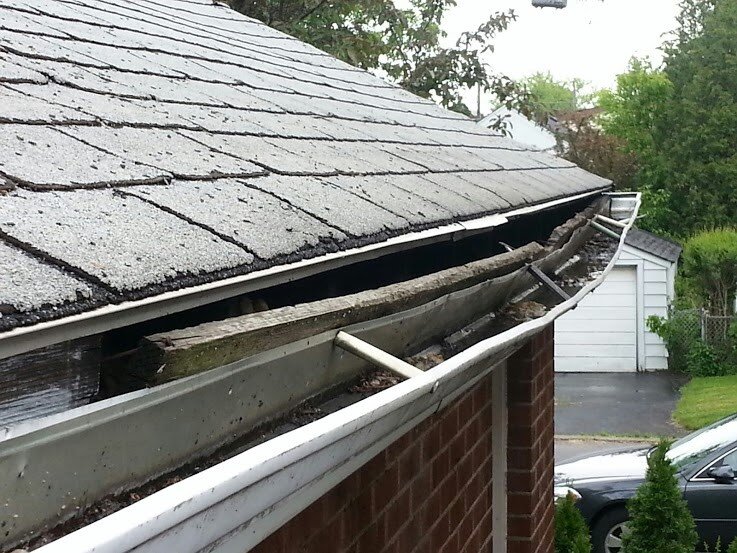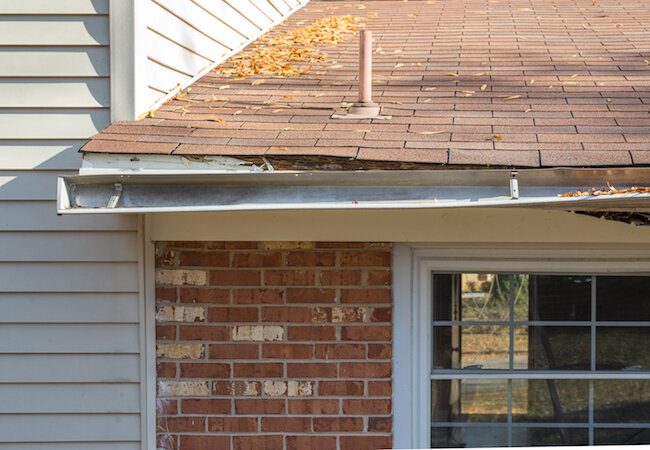And How to Do It Right the First Time
This past week has had a lot of rain for Plano and the surrounding areas. We’re not sick of it quite yet, but our homes might be. All of that water comes with lots of leaves and twigs hitting our roofs and being washed into the gutters. Which was fine. Up until it started leaking in your poor blogger’s kitchen. We learned a fair bit about our gutters this week and what they do for our homes. We’re sharing with you so you can avoid the same fate of having your kitchen flooded, at least if it’s due to clogged gutters.
Possible Damage
So what does it really matter? As long as some of the water is coming out of the gutters and downspouts you're all good, right? Not quite. There is a lot of damage that can be done from your gutters being clogged or otherwise not functioning properly.
Roof Damage
If your gutters are clogged the water can end up pooling and sitting on your roof. There the water is going to get under your shingles and your roof can end up rotting, cracking, and leaking. All of those damaged areas are going to continue growing and becoming worse with each new rain.
Increased Chance of Ice Dams
When we talked about water pooling on the roof and in the gutters themselves, we didn't talk about winter. During the cold months, like this past February, that water will turn into ice dams. Large heavy chunks of ice that can rip the gutters off your roof, if you're lucky. If you're not lucky they can begin damaging your roof, depending on the size of the pool to begin with.
Foundation Damage
If a storm happens during winter sitting water can begin to cause expansions and cracks in your foundation as it freezes and melts. As the water pools and sits on the ground, it leaches into the concrete of your foundation.
Heading inside to your basement, if you're lucky enough to have one in Texas, water is still a problem. Once water starts getting into your basement it opens up all sorts of problems. It can leak in through your foundation or through the void spaces between walls. That water can spread and result in gas leaks or electrical shocks.
Fire Hazard
When water spreads through your basement, or the walls in your house, it can end up coming in contact with wires. If there is a fuse as part of the system, then you’ll be dealing with a short circuit and a blown fuse. If however there isn’t a fuse, the water can heat up to the point of causing an electrical fire.
Shifts and Cracks in Driveway & Sidewalk
Just like with your foundation, water can pool on top of or under your driveway and sidewalk. With time the ground underneath can be eroded. Or the water can freeze, causing shifts and cracks.
Ruined Landscaping
You spend a lot of time and money making your yard look the way you want. A blocked gutter or downspout, is going to cut new channels through the ground following the path of least resistance. This means you'll end up with plants that are getting too much water, plants that have had their beds destroyed, and all sorts of pests moving in.
All of these are problems that can, do, and have happened to people all over the Plano area.
Signs To Look For
Now you know why you should care. The question is what are you looking for? To inspect your gutters, we advise waiting until a few days after it's rained. This way if you decide to start cleaning that same day you aren't going to be dealing with wet heavy debris. That’s not always possible though as sometimes it’s a storm happening that brings the problem to your attention.
Visible overflow during heavy rains
clogged gutter overflowing with rain
Of course if you are in the middle of a rain storm while reading this, you might look outside and see visible overflow from your roof. This is more than just a few drops here and there from hitting the edge of the gutters and dripping down. This is having a curtain of water at the edge of your gutters because the water isn't being diverted.
Unexplained water in basement
During or after a storm you might find unexpected pools of water in your basement. This means that the water is seeping in through your foundation either through pre-existing cracks or ones that have been created.
Water inside the home
You might also have water on your first or second floors. This would be where you have water coming down from the gutters and running right down the siding of your home. You're siding isn't meant to withstand constant rain running against it. The water gets under the siding and into the void between the walls and begins to eat away at your drywall.
Paint damage or rust
On a sunny day start by looking at the inside and outside of the gutters by eye. Look for spots where the paint is damaged or there's bare metal that has rusted. The paint on your gutters is formulated to be water resistant. If it's chipping or has rusted, it means there is, or has been, water sitting for an extended period of time.
Pools of water and mold
Gutter with mold, rust and pulling away from the roof
One of the most obvious things you'll see is going to be areas where water has pooled in the gutters and is still there even after things have been dry for a day or so. Or you might see mold buildup even if it's been dry for several weeks, you know that water has been standing in that area.
Sagging or collapsing gutters
Sagging-Gutter pulling away from the roof and tipping over.
Spots where the gutters are pulling away from the fascia boards or flat out collapsing are glaring signs that something is wrong. The fascia boards are the wooden supports that the gutters attach to on your roof. if the gutters are pulling away at those it means water has begun to eat away at them and they can no longer sustain the weight of the clogged up gutters.
How To Clean Your Gutters
You've decided that you want to clean your gutters and prevent all of this mess? Great! We'll walk you through the process and if at the end of it you decide it's too much, that's fine we advocate hiring a professional.
Avoid doing it right after rain
Much like looking for the signs of gutter damage, if at all possible you want to clean your gutters after it's been dry for several days. It's much easier to remove leaves and twigs and whatever else has clogged them when it's dry rather than when it's heavy and wet and compacted.
At least twice a year
Ideally you want to clean your gutters twice a year. Once in spring to get them ready for the heavy spring and summer rains. And once in fall to clean up the damage from those rains. The exception to this is if you have pine trees close to your house at any point. Since pine trees shed throughout the year you should look at cleaning your gutters every 3 months.
Spread a tarp under the ladder to protect your lawn and also to catch all of the gunk
This one is pretty self-explanatory. If you lay out the tarp ahead of time, he'll catch everything rather than having to clean it up afterwards when you're already tired.
Practice ladder safety
If you're not comfortable going up on a ladder, please don't. Hire a professional or even have a family member that is comfortable with ladders. Otherwise, the basic rules of ladder safety apply. Make sure you have it fully open and on level ground.
Use two pairs of gloves. One rubber and one working pair.
The idea here is that the rubber pair will keep your hands and arms from getting wet or terribly dirty while the working pair keeps you from getting cut up.
Begin cleaning debris near the downspout and work backwards
A trowel is a handy addition for leaning out your gutters.
Now that we've covered safety matters let's tackle the gutters. Start at the downspout and work your way backwards a long till the end points. You can use a trowel, your hands, or a gutter scoop if you happen to have one. You want to get out anything that doesn't belong. Sticks leaves random ribbons bits of stray balloons, and whatever else the wind might have brought you.
Remove and clean downspout strainer
Once you have the gutters clean, go back and clean out the downspout strainer.
Testing Time
Now it's time for your first test. Starting at the end turn on your hose with a spray nozzle and use that to rinse out any dirt, aiming for the downspout. Make sure not to be spraying up under your shingles or else you'll be adding to the problems.
Cleaning the Downspout
Hopefully your water will flow towards the downspout and out without any obstruction. If however you see that the amount of water coming out of the downspout is not the same as what you're putting out with the hose you need to move on to cleaning that out.
Start at the bottom and feed your hose up into the downspout turn on the hose on full power. Hopefully this will dislodge anything that's in there. If not you can grab a plumber's snake and attack it from the top. After each cycle of hoes and snake, try flushing the system again. Eventually this process will break up whatever is in your downspout allowing it to flush out.
Inventive Methods
These are a few ways people have found to clean their gutters that are at least interesting, if not necessarily recommended by us.
A leaf blower with a narrow nozzle attachment
A Power washer
Gutters serve an important purpose for our homes. They help keep our grooves from breaking down under the weight of water. Why not take a few minutes on a sunny day to make sure that they're in working order.
If you have any horror stories from cleaning, repairing, or maybe not doing that for your gutters let us hear them over on our Facebook page or in the comments down below.
If it's the inside of your home that's giving you trouble, maybe one of your kitchen appliances, or your dryer, give us a call. Even when we cover other areas of the home, we're still the best appliance rescue service in the Plano area. We want to keep your appliances in tip top shape. You can get hold of us by phone at ((214) 599-0055) or on our website.




